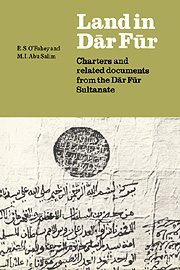Book contents
- Frontmatter
- Contents
- Preface and acknowledgements
- List and concordance of documents
- Transliteration and abbreviations
- Chapter 1 The Dār Fūr Sultanate
- Chapter 2 Estate and privilege
- Chapter 3 Literacy and Chancery
- Chapter 4 A Diplomatic Commentary
- Chapter 5 Translations and Commentary
- Sources and bibliography
- Notes
- Indices
Chapter 4 - A Diplomatic Commentary
Published online by Cambridge University Press: 16 November 2009
- Frontmatter
- Contents
- Preface and acknowledgements
- List and concordance of documents
- Transliteration and abbreviations
- Chapter 1 The Dār Fūr Sultanate
- Chapter 2 Estate and privilege
- Chapter 3 Literacy and Chancery
- Chapter 4 A Diplomatic Commentary
- Chapter 5 Translations and Commentary
- Sources and bibliography
- Notes
- Indices
Summary
Physical description and language
The documents were written in black ink on imported handmade paper which came mainly from Italy via Egypt. The sultanate must have consumed paper in considerable quantities; documents were written only on the recto, often with a wide right-hand margin, and the writing is not crabbed in an effort to save paper. In fact Dār Fūr appears to have re-exported paper further west. The documents do not conform to any standard size; the average is perhaps between 25 to 30 by 15 to 20 centimetres.
The range of literary competence, from the perspective of “standard” Arabic, is very broad; II, for example, is stylistically a polished production, while XXXI has several very colloquial passages. A detailed study of the local forms and deviations can only be profitably pursued in conjunction with a study of the different forms of Dār Fūr colloquial Arabic.
Over and above the occasional scribal error, there are certain consistent misspellings, for example the use of “t” for tā marbūṭa as in haḍra “presence”. Some of these errors of orthography arise from the transfer of speech habits to the written form; thus “s” for “ṣ” or “th”, “t” for “th”, and “h” for “ḥ”. Also common is a tendency to drop the alif maqṣūra.
Lexically a number of usages appear in the documents, the most numerous being the topographical and botanical names which are listed in a separate index (see pp. 157–8).
- Type
- Chapter
- Information
- Land in Dar FurCharters and Related Documents from the Dar Fur Sultanate, pp. 26 - 34Publisher: Cambridge University PressPrint publication year: 1983



